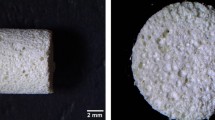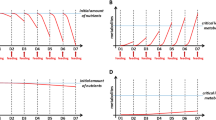Abstract
Bioreactors can be used to apply fluid flow in vitro to scaffolds to improve mass transport of media and apply mechanical forces to cells. In this study, we developed and tested an autoclavable, modular perfusion bioreactor suitable for large scaffolds. We investigated the effects of fluid flow induced shear stress (FFSS) on osteogenic differentiation of human embryonic stem cell-derived mesenchymal progenitors (hES-MP cells) cultured on large polyurethane (PU) scaffolds (30 mm diameter × 5 mm thickness) in osteogenesis induction media (OIM). After seeding, scaffolds were either maintained in static conditions or transferred to the bioreactor 3 days post-seeding and a continuous flow rate of 3.47 mL/min was applied. Alkaline phosphatase activity (ALP) was used to evaluate osteogenic differentiation and resazurin salt reduction (RR) to measure metabolic activity after 10 days. Cultures subjected to flow contained significantly more metabolically active cells and higher total DNA content, as well as significantly higher ALP activity compared to scaffolds grown in static culture. These results confirm the responsiveness of hES-MP cells to fluid flow stimuli, and present a cost-effective, user-friendly bioreactor capable of supporting the growth and differentiation of mesenchymal progenitor cells within scaffolds capable of filling large bone defects.




Similar content being viewed by others
References
Stops, A.J., Heraty, K.B., Browne, M., O'Brien, F.J., McHugh, P.E. (2010), Journal of biomechanics, 43(4): 618–626.
Venugopal, J., & Ramakrishna, S. (2005). Applications of Polymer Nanofibers in Biomedicine and Biotechnology. Applied Biochemistry and Biotechnology, 125(3), 147–157. https://doi.org/10.1385/ABAB:125:3:147.
Mekala, N. K., Baadhe, R. R., & Potumarthi, R. (2014). Mass transfer aspects of 3D cell cultures in tissue engineering. Asia-Pacific Journal of Chemical Engineering, 9(3), 318–329. https://doi.org/10.1002/apj.1800.
Plunkett, N., & O'Brien, F. J. (2011). Bioreactors in tissue engineering. Technology and Health Care, 19(1), 55–69. https://doi.org/10.3233/THC-2011-0605.
Martin, I., Wendt, D., & Heberer. (2004). TRENDS in. Biotechnology, 22(2), 80–86.
Yu, Y., Li, K., Bao, C., Liu, T., Jin, Y., Ren, H., & Yun, W. (2009). Ex Vitro Expansion of Human Placenta-Derived Mesenchymal Stem Cells in Stirred Bioreactor. Applied Biochemistry and Biotechnology, 159(1), 110–118. https://doi.org/10.1007/s12010-009-8556-5.
Cartmell, S.H., Porter, B.D., García, A.J. and Guldberg, R.E. (2003), Tissue engineering, 9(6): 1197–1203.
Wendt, D., Marsano, A., Jakob, M., Heberer, M., Martin, I. (2003), Biotechnology and bioengineering, 84(2): 205–214.
Carver, S.E. and C.A. Heath. (1999), Biotechnology and bioengineering, 62: 166–74.
Jaasma, M. J., & O'brien, F. J. (2008). Mechanical Stimulation of Osteoblasts Using Steady and Dynamic Fluid Flow. Tissue Engineering Part A, 14(7), 1213–1223. https://doi.org/10.1089/ten.tea.2007.0321.
Bancroft, G. N., Sikavitsas, V. I., Van Den Dolder, J., Sheffield, T. L., Ambrose, C. G., Jansen, J. A., & Mikos, A. G. (2002). Proceedings of the. National Academy of Sciences, 2002., 99(20), 12600–12605. https://doi.org/10.1073/pnas.202296599.
Vetsch, J.R., R. Müller, and S. Hofmann. (2015), Journal of tissue engineering and regenerative medicine, 9(8): 903–917.
Meinel, L., Karageorgiou, V., Fajardo, R., Snyder, B., Shinde-Patil, V., Zichner, L., Kaplan, D., Langer, R., Vunjak-Novakovic, G. (2004), Annals of biomedical engineering, 32(1): 112–122.
Gomes, M.E., Holtorf, H.L., Reis, R.L., Mikos, A.G. (2006), Tissue engineering, 12(4): 801–809.
Yeatts, A. B., Both, S. K., Yang, W., Alghamdi, H. S., Yang, F., Fisher, J. P., & Jansen, J. A. (2013). In vivo bone regeneration using tubular perfusion system bioreactor cultured nanofibrous scaffolds. Tissue Engineering Part A, 20(1–2), 139–146. https://doi.org/10.1089/ten.TEA.2013.0168.
Zermatten, E., Vetsch, J.R., Ruffoni, D., Hofmann, S., Müller, R., Steinfeld, A. (2014), Annals of biomedical engineering, 42(5): 1085–1094.
Fan, J., Jia, X., Huang, Y., Fu, B. M., & Fan, Y. (2015). Journal of Tissue Engineering and Regenerative Medicine, 9(12).
Filipowska, J., Reilly, G. C., & Osyczka, A. (2016). A single short session of media perfusion induces osteogenesis in hBMSCs cultured in porous scaffolds, dependent on cell differentiation stage. Biotechnology and Bioengineering, 113(8), 1814–1824. https://doi.org/10.1002/bit.25937.
Edwards, J. (2013), PhD Thesis, University of Sheffield, Sheffield, UK.
Owen, R., Sherborne, C., Paterson, T., Green, N. H., Reilly, G. C., & Claeyssens, F. (2016). Emulsion templated scaffolds with tunable mechanical properties for bone tissue engineering. Journal of the Mechanical Behavior of Biomedical Materials, 54, 159–172. https://doi.org/10.1016/j.jmbbm.2015.09.019.
Hoemann, C. D., El-Gabalawy, H., & McKee, M. D. (2009). In vitro osteogenesis assays: Influence of the primary cell source on alkaline phosphatase activity and mineralization. Pathologie Biologie, 57(4), 318–323. https://doi.org/10.1016/j.patbio.2008.06.004.
Farley, J. R., Wergedal, J. E., & Baylink, D. J. (1983). Fluoride directly stimulates proliferation and alkaline phosphatase activity of bone-forming cells. Science, 222(4621), 330–333. https://doi.org/10.1126/science.6623079.
Quarto, R., Mastrogiacomo, M., Cancedda, R., Kutepov, S. M., Mukhachev, V., Lavroukov, A., Kon, E., & Marcacci, M. (2001). Repair of Large Bone Defects with the Use of Autologous Bone Marrow Stromal Cells. New England Journal of Medicine, 344(5), 385–386. https://doi.org/10.1056/NEJM200102013440516.
S Sittichockechaiwut, A., Scutt, A.M., Ryan, A.J., Bonewald, L.F., Reilly, G.C. (2009), Bone, 44(5): 822–829.
Sittichokechaiwut, A., Edwards, J. H., Scutt, A. M., & Reilly, G. C. (2010). European Cells & Materials, 20(4).
Gaspar, D.A., Gomide, V and Monteiro, F.J. (2012), Biomatter, 2(4):167–175.
Wittkowske, C., Reilly, G. C., Lacroix, D., & Perrault, C. M. (2016). Frontiers in Bioengineering and Biotechnology, 4.
Gurkan, U.A. and O. Akkus. (2008), Annals of biomedical engineering, 36(12): 1978–1991.
Ichinohe, N., Takamoto, T., & Tabata, Y. (2008). Proliferation, osteogenic differentiation, and distribution of rat bone marrow stromal cells in nonwoven fabrics by different culture methods. Tissue Engineering Part A, 14(1), 107–116. https://doi.org/10.1089/ten.a.2007.0021.
Delaine-Smith, R. M., MacNeil, S., & Reilly, G. C. (2012). Matrix production and collagen structure are enhanced in two types of osteogenic progenitor cells by a simple fluid shear stress stimulus. European Cells & Materials, 24, 162–174.31. 10.22203/eCM.v024a12.
Jaasma, M. J., Plunkett, N. A., & O’Brien, F. J. (2008). Design and validation of a dynamic flow perfusion bioreactor for use with compliant tissue engineering scaffolds. Journal of Biotechnology, 133(4), 490–496. https://doi.org/10.1016/j.jbiotec.2007.11.010.
Acknowledgements
We would like to acknowledge the British Council (UK) and Department of Biotechnology (DBT, Government of India; No: BT/IN/NBPP/BB/04/15-16) funding for this project under the Newton-Bhabha PhD Placement programme 2015. We would also like to acknowledge the funding provided by DBT, Govt of India, and Project No: BT/PR8056/MED/31/215/2013. Special thanks go to the Mechanical Engineering workshop, University of Sheffield, UK. We also thankful to Naveen Kumar Mekala (Postdoctoral Fellow, Wayne State University, USA) and Jasmin Monpora (ICT Mumbai) for helpful discussions about the experimental design. RO was funded by a UK Engineering and Physical Sciences Research Council (EPSRC) studentship.
Author information
Authors and Affiliations
Corresponding author
Ethics declarations
Conflicts of Interest
The authors have no financial conflicts of interest.
Ethical Statement
We declare that there are no ethical issues for human or animal rights in the work presented here.
Rights and permissions
About this article
Cite this article
Bhaskar, B., Owen, R., Bahmaee, H. et al. Design and Assessment of a Dynamic Perfusion Bioreactor for Large Bone Tissue Engineering Scaffolds. Appl Biochem Biotechnol 185, 555–563 (2018). https://doi.org/10.1007/s12010-017-2671-5
Received:
Accepted:
Published:
Issue Date:
DOI: https://doi.org/10.1007/s12010-017-2671-5




